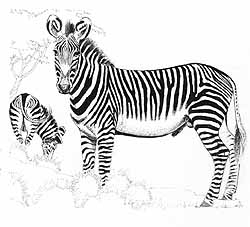English: Grevy’s Zebra; French: Zèbre de Grévy; Amharic: Yegrevi Meda Aheya; Kikuyu: Njagi; Maasai: oloitiko.
 |
Former distribution: Northern Kenya, Ethiopia and Somalia.
Present distribution: Ethiopia, Kenya from the northern areas south to Tana river, Mount Kenya, west to the Lake Turkana, east to Garissa and the Lorian swamps. Somalia? Introduced into the Tsavo National Park, 1964.
Behaviour: Preferred habitat: arid, semi-desert bushlands; they are grazers and need water once a day, at least every 3 days. They live both singly and in family groups – sometimes in mixed herds of up to 100. Stallion groups are also normal: main activity in the morning and late afternoon.
Population status: Endangered. Total estimated numbers: 3-4000. Declining.
Brief notes:
Body weight: 350-430 kg
Head and body length: 250-275 cm
Tail length: 50-75 cm
Shoulder height: 150-155 cm
Gestation period: 12 months
Maximum age: 21 years in captivity
Trophy: Skull, no records.
Hunting methods: Formerly by stalking, on horseback. Now protected by law.
Remarks: In Ethiopia the populations declined as a result of civil war activities. Poaching in all countries concerned is due to the high prices for its skin. Grevy’s Zebras may survive in some of the national parks such a Tsavo, Sibiloi, Meru and Samburu. In 62 zoological gardens worldwide up to 400 are bred.






